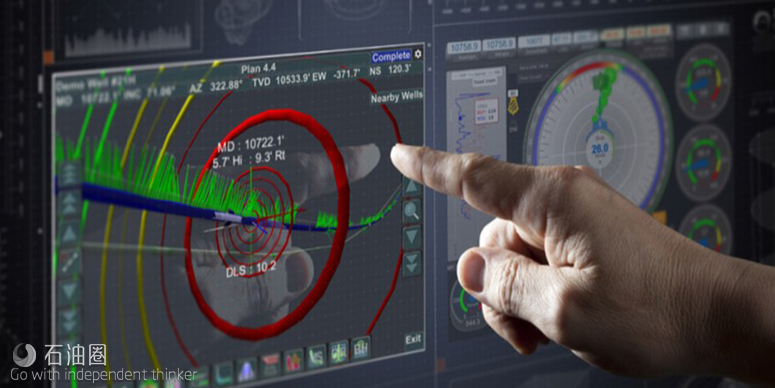One of the most significant directional drilling problems recognized by operators when drilling horizontal and extended-reach wells is inconsistency following the prescribed well path specified collectively by geologists, geophysicists and reservoir engineers. This inconsistency degrades performance, increases both the drilling and lifting costs and reduces the hydrocarbon production potential of the well. However, this inconsistency can be reduced using automated bit guidance.
Directional challenges
In the development of unconventional resources, horizontal wells are drilled in parallel at a spacing distance designed to maximize drainage of the reservoir without overcapitalizing the field. Lateral well spacing should be designed to make the drainage radiuses meet without excessive overlap. If drainage areas do not meet, then oil and gas reserves are left stranded in the reservoir. However, the limited accuracy of downhole surveying methods together with positional errors in wellbore placement often lead to deviations by hundreds of feet from the optimal wellbore position. The challenge becomes more pronounced as lateral lengths increase.
In the 2016 paper “Simulation of Recovery Losses Due to Positional Errors in Wellbore Placement,” Stefan Maus, et al. presented a hydrocarbon recovery simulator that approximates the effect of wellbore positional error on reservoir drainage. The simulator uses input parameters to define different drilling scenarios to evaluate. The input parameters include lateral wellbore length, lateral well spacing, wellbore direction, surveying methodology and recovery percentage as a function of the drainage radius.
Using the latest error models of the Industry Steering Committee on Wellbore Survey Accuracy, the application was used to simulate a large number of drilled wellbores. The simulation assessed the expected amount of oil or gas left in the field due to inaccurate wellbore placement. The application also provided statistics on the likelihood of wellbore crossovers and lease line infractions. Results from this paper indicated that systematic errors in wellbore placement could lead to hundreds of thousands of dollars in unclaimed hydrocarbons per well for a typical multiwell pad when using traditional and standard MWD methods for directional drilling.
While attempting to both stay on a defined path to maximize recovery and striving to drill as quickly as possible, directional drillers often fail to compensate for the multiple rapidly changing and complex variables, like variations in rotary walk and build, inconsistent motor yields, bit deflections and more. There are too many variables for the directional driller to consider and respond to in real time consistently and predictably.
This leads to suboptimal directional drilling decisions, which adversely impact well economics with slower drilling, higher lifting costs, lost time, sidetracks, lower recovery factor, more frequent tool failures, difficulty running casing and completions hardware, higher water production and liquid holdup, and increased occurrences of fracture hits.
Bit guidance
These consequences can be reduced significantly by automating advanced MWD data analytics, forward modeling of the bit position and cost function decision-making in real time. The Motive Bit Guidance System (BGS), a proprietary technique developed by Motive Drilling Technologies, is a completely new method for steering that optimizes bit navigation along the desired well path in real time. Integrating the BGS with realtime geosteering and automated formation top detection enables more efficient, predictable and accurate positioning of the wellbore while drilling horizontal and extended-reach wells.
More than 500 horizontal and extended-reach wells have been successfully guided by Motive’s BGS with more than a dozen different directional service providers.
The BGS is designed to automatically perform all standard calculations normally performed by a directional driller but with greater consistency and precision. The system also executes multivariable engineering and economic analyses to improve decision-making intelligence, which is made possible using high-speed computing together with advanced algorithms. The driller is provided with continuous instructions for when to slide, for how many feet and at what toolface orientation for optimized steering. By having the BGS perform the intensive computational processing and decision-making, field personnel can place more focus on safety, equipment and other activities that enhance wellsite operations.
The BGS is complemented with dynamic systems provided by Magnetic Variation Services to increase the overall confidence in the calculated wellbore position. Decisions made with better positional data are critical to maximizing the net economic outcome of the drilled wellbore. More than a dozen different directional drilling companies have successfully drilled more than 500 horizontal and extended-reach wells following Motive’s BGS.
Results have demonstrated factory-like consistency made possible by BGS’s automation. One particular client has observed a reduction in the number of unplanned sidetracks as compared to wells being steered without the aid of the BGS. In another example, the BGS helped reduce the curve and lateral to a single bottomhole assembly (BHA) run where previously multiple planned BHA trips were required. Many operators have benefited from faster drilling through better data utilization and analytics made possible by the BGS. In many cases, operators have reduced lifting costs because of less tortuous wellbores and improved hydrocarbon production potential by drilling with better accuracy and with less tortuous wellbores. Moreover, for some operators in the forefront of the digital oil field, it is laying a solid foundation for remote directional drilling and future automated drilling.

 石油圈
石油圈
